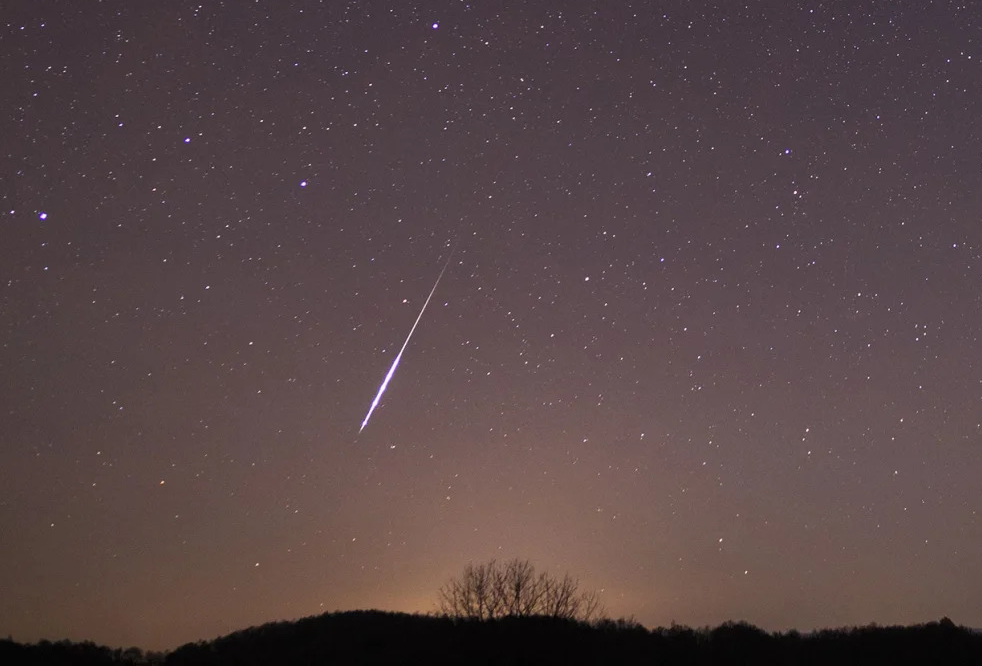Description

Disclaimer: Copyright infringement not intended.
Context
A celestial light show will grace the night sky as the Taurid meteor shower reaches its peak.
About
- The Taurid meteors are fragments of the periodic Comet 2P/Encke, which has the shortest known orbital period for a comet (just 3.3 years to complete one complete circle around the sun).
- These showers are named after the Taurus constellation.
- It is different in that it consists of two independent streams (the Southern and Northern Taurids), both of which have spread over time due to Jupiter's gravitational effect.
- It is visible to the naked eye and is best observed after midnight.
- On peak evenings, these are modest, with less than 10 shooting stars per hour.
- However, November is one of the best months for shooting stars due to the abundance of irregular meteors.

What is Meteoroid, Meteor and Meteorite?
- A meteoroid is an object in space that ranges in size from dust grains to small asteroids.
- When meteoroids enter Earth’s atmosphere (or that of another planet, like Mars) at high speed and burn up, the fireballs, or “shooting stars” are called meteors.
- When a meteoroid survives a trip through the atmosphere and hits the ground, it’s called a Meteorite.
What is the significance of meteors?
- It aids in comprehending early circumstances and processes in the history of the solar system.
- These include the age and composition of various planetary building elements, the temperatures attained on asteroids' surfaces and innards, and the degree to which materials were previously shocked by impacts.
About Meteors
- Definition: Meteors, commonly known as shooting stars, are the visible streaks of light produced when small pieces of cosmic debris, known as meteoroids, enter the Earth's atmosphere and burn up due to friction with the air.
- Formation: Meteoroids are typically remnants of asteroids or comets that have broken off due to collisions or other factors. They can range in size from small grains to boulder-sized objects.
- Types of Meteors: There are different types of meteors, including sporadic meteors (not associated with any particular meteor shower), meteor showers (occur when the Earth passes through the debris left by a comet), and meteorite-producing fireballs (which survive atmospheric entry and hit the ground).
- Significance: Meteors provide valuable information about the composition of the Solar System. Studying their characteristics and trajectories can offer insights into the nature of asteroids, comets, and other celestial bodies.
About Comets
- Definition: Comets are cosmic bodies composed of dust, ice, and volatile compounds that orbit the Sun. As they approach the inner Solar System, they heat up, releasing gas and dust, creating a visible coma (a fuzzy atmosphere) and sometimes a tail.
- Formation: Comets are believed to be remnants from the early stages of the Solar System's formation. They are composed of dust, rock, and volatile compounds such as water, ammonia, and methane, trapped in a mixture of water ice and other frozen gases.
- Structure: Comets typically consist of a nucleus, coma, hydrogen envelope, dust tail, and ion tail. The nucleus is the solid core of the comet, while the coma is the nebulous envelope of gas and dust surrounding the nucleus. The tails are formed as a result of solar radiation and the solar wind.
- Orbital Paths: Comets can have either short or long orbital periods. Short-period comets, like Halley's Comet, have orbital periods of less than 200 years, while long-period comets can take thousands or even millions of years to complete a single orbit.
- Significance: Comets provide valuable information about the early Solar System's conditions and composition. They have played a crucial role in the delivery of water and organic molecules to Earth, potentially contributing to the development of life on our planet.

Conclusion
- Studying meteors and comets is vital for understanding the history and dynamics of the Solar System. These celestial objects offer valuable insights into the processes that have shaped the universe and continue to influence the development of life on Earth.
|
PRACTICE QUESTION
Discuss the significance of meteors and their impact on Earth, both in terms of scientific understanding and potential hazards. How can governments and international organizations mitigate the risks associated with meteor impacts?
|
















